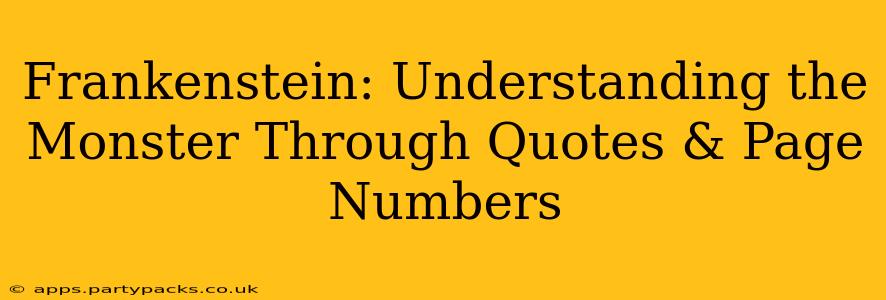Mary Shelley's Frankenstein is a masterpiece of Gothic horror, but its enduring power lies not just in its chilling atmosphere, but also in the complex character of the creature. Often misunderstood as a mindless brute, the monster possesses a sophisticated intellect and a tragic yearning for connection. Understanding his motivations and perspectives requires a close reading of the text, and examining key quotes within their textual context is crucial. This essay will explore the monster's character through significant quotes, referencing page numbers (assuming a common edition; page numbers may vary slightly depending on the specific edition used).
The Monster's Desire for Acceptance: A Central Theme
The monster's overriding desire is for acceptance and understanding. He's not inherently evil; his actions are largely a consequence of his rejection by society. This is powerfully illustrated in his reflections: "Did I request thee, Maker, from my clay / To mould me Man, did I solicit thee / From darkness to promote me?" (Page numbers will vary depending on the edition). This quote highlights the creature's sense of injustice and abandonment, underscoring that his existence is not of his own choosing. His creation is imposed upon him, and the subsequent rejection fuels his despair and ultimately, his rage.
"How can I move another to sympathy when even my creator repulses me?"
This unstated question underscores the monster's profound loneliness and isolation. He desperately seeks connection, but his appearance continually repels others, creating a vicious cycle of rejection. This deep-seated loneliness drives much of his actions, transforming him from a potentially benevolent being into a vengeful one. The monster's actions are, in many ways, a desperate cry for understanding and a response to the cruelty he faces.
What motivates the monster's actions in Frankenstein?
The monster's actions are primarily driven by his desire for acceptance and his reaction to the rejection and cruelty he faces. His initial innocence is gradually eroded by the constant fear and hatred he encounters. He initially seeks companionship and understanding, but his repeated attempts are met with violence and fear, leading him down a path of revenge. The monster's actions are a consequence of his creation and the society that rejects him.
Is the monster in Frankenstein evil?
Whether the monster is inherently evil is a complex question. His actions are undoubtedly horrific, but they are largely a consequence of his circumstances and his desperate need for connection. He is initially innocent, learning about the world and humanity through observation. It is the unrelenting rejection and cruelty he experiences that leads him to commit acts of violence. His nature isn't evil so much as a product of his suffering and the terrible circumstances of his creation.
What does the monster learn in Frankenstein?
Through observation and interaction (however limited and often traumatic), the monster learns about human nature, both its capacity for love and compassion, and its profound cruelty and prejudice. He learns about language and literature, which allows him to develop his intellectual capacity. This learning, however, only heightens his sense of isolation, as he understands more fully the chasm separating him from humanity. The knowledge he gains only amplifies his suffering and fuels his resentment.
What is the monster's appearance in Frankenstein?
The novel doesn't provide a precise, detailed description of the monster's physical appearance. Shelley relies on the reactions of others to emphasize his horrific, grotesque nature. This lack of explicit description allows the reader's imagination to fill in the gaps, making the monster all the more terrifying. It’s the implied horror of his appearance that fuels the fear and disgust of those who encounter him.
The Monster's Capacity for Compassion: A Contradiction?
Despite his vengeful actions, glimpses of compassion emerge throughout the novel. He demonstrates empathy towards the De Lacey family, initially drawn to their kindness and familial bond. This interaction emphasizes the monster's longing for connection, and his capacity for love, further complicating the simplistic notion of him as a pure villain. This underscores that the monster isn't born evil; his actions are the consequence of his horrific experience.
Conclusion: A Tragic Figure
Through a careful examination of key quotes and their contextual implications, we see the monster not as a simple monster, but as a tragically flawed creature, driven by understandable, though horrific, motivations. His story is a chilling testament to the consequences of rejection, prejudice, and the dehumanizing effects of societal cruelty. Understanding the monster through his own words allows us to appreciate the profound ethical and philosophical questions at the heart of Shelley's masterpiece.

